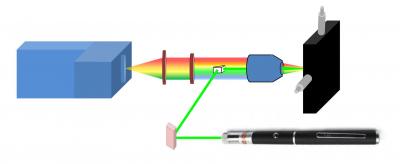Oct 11 2012
By using an ordinary green laser pointer, the kind commonly found in offices and college lecture halls, an Israeli research team has developed a new and highly portable Raman spectrometer that can detect extremely minute traces of hazardous chemicals in real time.
 This is a schematic drawing of the Raman spectrometer, including a laser pointer, dichroic mirror, prism, objective, x,y motorized translational stage, long wavepass edge filter, lens and a detector (spectrometer/intensified charge-coupled device). Credit: Image courtesy Ilana Bar, Ben Gurion University of the Negev
This is a schematic drawing of the Raman spectrometer, including a laser pointer, dichroic mirror, prism, objective, x,y motorized translational stage, long wavepass edge filter, lens and a detector (spectrometer/intensified charge-coupled device). Credit: Image courtesy Ilana Bar, Ben Gurion University of the Negev
The new sensor's compact design makes it an excellent candidate for rapid field deployment to disaster zones and areas with security concerns. The researchers will present their findings at Laser Science XXVIII—the American Physical Society Division of Laser Science's Annual Meeting—collocated with the Optical Society's (OSA) Annual Meeting, Frontier in Optics (FiO), taking place in Rochester, N.Y. next week.
Raman spectrometers rely on highly focused beams of light at precise wavelengths to illuminate small samples of materials. Very sensitive detectors then study the spectra of light that has been re-emitted, or scattered, by the sample. Most of this scattered light retains its original frequency or color, but a very small percentage of that light is shifted ever so slightly to higher or lower wavelengths, depending on the unique vibrational modes of the sample being studied. By comparing the shifted and the original wavelengths, it's possible to determine the precise chemicals present in the sample.
The researchers brought this capability down to size by constructing their Raman spectrometer using a low-power and low-cost commercial green laser pointer. The green laser's relatively short wavelength helped to improve the detection of the inherently weak Raman signal. The spectrometer also has the capability to first scan the entire sample optically, sweeping from side to side, to locate individual particles of interest – a task usually performed by large and cumbersome Raman microscopes.
"Since the overall system is modular, compact, and can be readily made portable, it can be easily applied to the detection of different compounds and for forensic examination of objects that are contaminated with drugs, explosives, and particularly explosive residues on latent fingerprints," said Ilana Bar, a researcher with the Department of Physics at Ben-Gurion University of the Negev in Israel. "With proper investment this system could be deployed quite quickly as a consumer product." Other members of the research team include Itamar Malka, Alona Petrushansky, and Salman Rosenwaks.
Presentation LTh3I.3, "Detection of Explosives and Latent Fingerprint Residues Utilizing Laser Pointer Based Raman Spectroscopy," takes place Thursday, Oct. 18 at 2:30 p.m. EDT at the Rochester Riverside Convention Center in Rochester, N.Y.